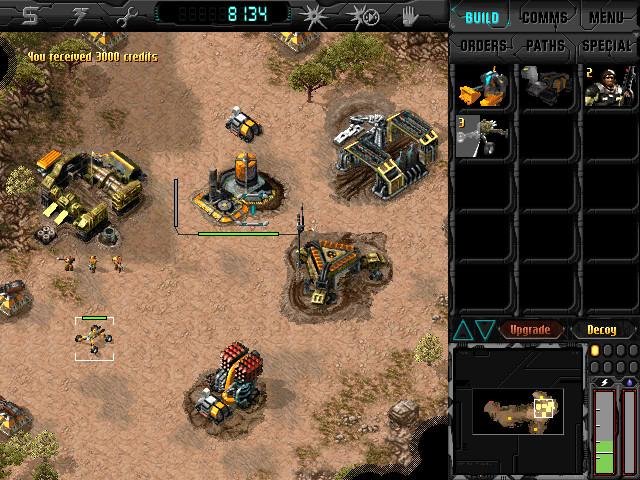Download Game Kknd Krossfire Portable Pc
Platform Windows 0 2 star. All Versions. Out of 24 votes. Play 12 solitaire card games on your PC. Portable KKND 2. Kill 'n Destroy 2 Lite is an updated version of KKnD2: Krossfire, the sequel to KKnD. This version features skirmish and LAN games over TCP/IP only, plus all.
Contents • • • • • • • • • History [ ] Home computer era [ ] In the early years, two of Beam's programs were milestones in their respective genres., a 1982 text adventure by Philip Mitchell and Veronika Megler, sold more than a million copies. It employed an advanced parser by Stuart Richie and had real-time elements. Even if the player didn't enter commands, the story would move on. In 1985 Greg Barnett's two-player game helped define the genre of one-on-one fighting games on the home computer. The game won Best Overall Game at the.
In 1987 Beam's publisher, parent company Melbourne House, was sold to for £850,000. Beam chairman Alfred Milgrom recounted, '.around 1987 a lot of our U.K. People went on to other companies and at around the same time the industry was moving from 8-bit to 16-bit. It was pretty chaotic.
We didn't have the management depth at that time to run both the publishing and development sides of things, so we ended up selling off the whole Melbourne House publishing side to Mastertronic.' Subsequently games were released through varying publishers.
The 1988 fighting games and Fist +, the third installment in the Exploding Fist series, were published through Firebird label. 1988 also saw the release of space- Bedlam, published by GO!, one of 's labels, and, published. Moj syabr sachinenne pa bel move lyrics. Shift to consoles and PCs [ ] In 1987 Nintendo granted a developer's licence for the and Beam developed games on that platform for US and Japanese publishers. Targeted at an Australian audience, releases such as and for the NES proved successful. [ ] In 1992 they released the original title, a dark superhero comedy game. The game was meant to be the first part in a series, but no sequels were ever made; however, it served as the basis for. In 1993 they released Shadowrun, with an innovative dialogue system using the acquisition of keywords which could be used in subsequent conversations to initiate new branches in the.
In 1997, Beam relaunched the Melbourne House brand, under which they published the PC titles (KKND), and the sequels KKND Xtreme. They released KKND2 in South Korea well before they released it in the American and European markets, and pirated versions of the game were available on the internet before it was available in stores in the U.S. They were the developers of the 32-bits versions of for the, and in 1996. They also helped produce games such as, and an updated version of International Cricket titled.
They will put you in touch with the national body/authority that can help with your case. Razvertka pyatiugoljnoj prizmi. Unfortunately, EU-OSHA is not permitted to give advice on specific safety and health situations, intervene in any law case or interfere with local or national authorities; we advise you to start by contacting your.
They ported the Sega Saturn game to in August, 1996. 1998 saw a return to RPGs with, again with a dialogue tree format. Also in 1998, the studio developed racing games. In 1999 Beam Software was acquired by and renamed to Infogrames Melbourne House. 2000s [ ] They continued to cement a reputation as a racing game developer with and (both and ), followed by the technically impressive (), before a disastrous venture into third-person shooters with (, ).

In 2004 the studio released for the based on the then current franchise. The game reached the top of the UK games charts, making it Melbourne House's most successful recent title. The studio then completed work on and ports of Eden's next-generation title. In December 2005, Atari decided to shift away from internal development, seeking to sell its studios, including Melbourne House.
In November 2006 announced that it had acquired Melbourne House from and that the studio would be renamed to Krome Studios Melbourne. Games [ ] As Beam Software/Melbourne House [ ] • 1982:,,, • 1984:, Hampstead,, • 1985:,,,, Wham! September 1997. Retrieved 19 April 2018.
Archived from on 11 June 2010. Documentation for a 2007 exhibition. • Sharwood, Simon (18 November 2012),,, retrieved 10 December 2012 • ^ DeMaria, Rusel and Wilson, Johnny L. (2004) High Score!: The Illustrated History of Electronic Games McGraw-Hill/Osborne, Berkeley, Calif., p.
Retrieved 2017-12-31. • Guter, Arthur (June 2016). Archived from on February 24, 2018. • 'In the Studio'. Retrieved 9 August 2009. • Al Giovetti.
The Computer Show. Retrieved 19 April 2018. • Foster, Lisa (17 February 2006). Intent Media. Archived from on 9 June 2007. Retrieved 2010-02-03. Krome Studios.
3 November 2006. Archived from on 29 September 2011. Retrieved 2010-02-03. • External links [ ] • via • at.
Gameplay Gameplay takes place after a world wide nuclear war, on three map-types over land and water: a barren desert terrain, forest areas, or urban jungles. All three areas provide artifacts from the nuclear war, namely decrepit buildings and polluted water.